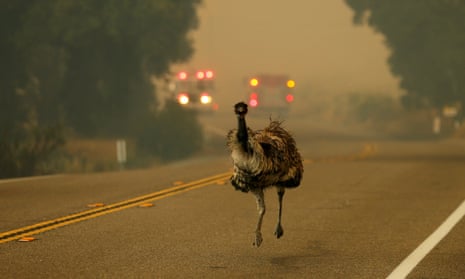The emu is caught mid-stride, beak agape and eyes agog. Under a smoke-darkened sky, it races down a rural highway with the glare of fire engines behind it.
The incongruous photograph of a giant bird native to Australia fleeing a California wildfire near the US-Mexico border captured our imaginations. Where did this fleeing emu come from?
Tracking down the owner of a wayward ratite (that’s the class of large, flightless birds that includes ostriches, emus and cassowaries) did not seem at first like too daunting a task. But it turns out that there were more than a few emu-related incidents around the border fire this week.
On Monday evening, the same day that the flightless flight of the emu was photographed, a 32-year-old man was arrested for allegedly firing a shotgun to scare off an animal services worker who was attempting to rescue an emu with singed feathers from his property.
“When all heck broke loose, the emu took off,” said Dan DeSouse, deputy director of the San Diego County division of animal services.
Mike Blake, the Reuters photographer who snapped the image of the emu, only saw it briefly.
“It all happened in a few seconds,” Blake said. “The emu zooms past me as I zoomed out with my lens, I spun and followed him around as he headed off into a field away from the flames.”
The next day, Blake came across another emu nearby, this time being herded off the highway by officers from the San Diego sheriff’s department, Cal Fire, and the US Customs and Border Protection. That emu also made a run for it, Blake said.

Ralph DeSio, a spokesman for the border protection, was unsure about the final disposition of that emu but said, “I’m sure it was pushed toward safety. I haven’t heard about any barbecued emu.”
And a third emu is currently in the custody of the county, having been tracked down at another location by animal control workers. It has yet to be claimed by its owner.
The question is whether these are all the same emu, or whether a surprising number of emus are on the loose in the San Diego county backcountry.
“I hate to say it,” DeSouse said, “but one emu looks a lot like another emu.”
Em-who?
The emu in the photograph is likely a leftover from the emu craze of the 1990s. The world’s second largest bird, emus are farmed for their lean meat, giant green eggs, double feathers, and the oil derived from their fat. Adherents to emu oil, which is applied to the skin, ascribe it near mystical powers.
“I’m 72 years old, and if you look at my skin, you would think I’m 45,” said Willi Seeger, owner of Rancho San Diego Emus.
Seeger was one of about 60 ranchers in San Diego county who got into the emu business 20-some years ago, and one of just a couple of those still farming emus. “The problem is you have people who were looking to make a quick buck, not looking to do the hard work involved.”

Seeger, whose ranch is about 30 miles from the site of the border fire, is fairly certain that the wildfire emu is someone’s pet, because he’s not aware of any emu farmers in that area. The birds do make good pets, he said, as long as the owner has an acre or two of land.
“An ostrich is mean, a cassowary will kill you,” he said. “Emus, on the other hand, they’re just real gentle.”
Billie Jo Jannen, a retired news person who lives on the same property as the man who was arrested for firing his shotgun, said that that emu, at least, belongs to her neighbor, “an elderly fellow that lives down the road”. But Jannen would not disclose the name or address of the emu owner.
“I don’t know that he particularly wants me to be discussing him and his emus,” she said. “I don’t think he’s a farmer. I think he kind of just keeps them around.”
Jannen has remained on her property near the town of Campo, despite orders from officials to evacuate. She has horses, dogs, cats and a bearded dragon on her property. She was present during the shooting incident and resents the intrusion of animal control workers.
“Animal control basically came in here like cowboys and refused to leave,” she said Wednesday, adding, “The owner is going to go through hell trying to get the animal back.”
Not so, said DeSousa, whose agency has helped evacuate 75 miniature donkeys, 30 dogs, 22 chickens, some goats and the mystery emu since the fire began on Sunday.
“They just need to come down and say ‘this is my emu’,” he promised.

Comments (…)
Sign in or create your Guardian account to join the discussion